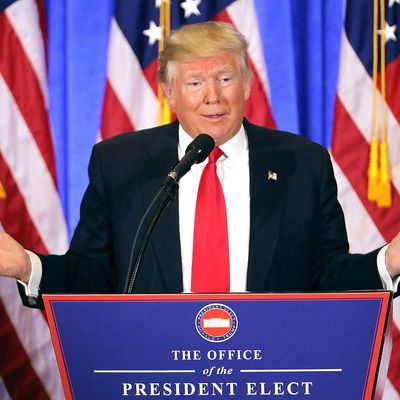
President Trump has promised to cut taxes on the rich; increase spending on the military; build a wall on the southern border; spend $1 trillion on infrastructure; leave Social Security and Medicare untouched; and balance the federal budget.
Which is a bit like promising to add seven cronuts to your daily diet; stop exercising; drink nothing but Mountain Dew; and lose 30 pounds by month’s end.
Since his election, Trump has made some concessions to fiscal reality. The president no longer demands a balanced budget in the immediate term. Instead, he merely wishes to cut taxes and increase spending, while reducing the deficit in the long term.
The president’s plan for accomplishing this (impossible) goal, appears to be two-pronged:
(1) Baselessly assume that economic growth will be a full percentage point higher than the Congressional Budget Office expects.
(2) Eliminate a bevy of discretionary programs that, together, account for $2.5 billion of the government’s annual $4 trillion budget.
The notion that cutting taxes on the rich will rapidly accelerate growth because businessmen and entrepreneurs will have more incentive to invest in new companies has been a cornerstone of Republican economic thinking since Reagan. It is also demonstrably false.
But what supply-side economics lacks in empirical validity it makes up for in political utility: If you assume tax cuts spur significantly higher economic growth, then you can claim that they actually pay for themselves — after all, higher growth means a larger tax base, and lower costs on stabilizing programs like unemployment insurance and food stamps.
It would be surprising, then, if Trump didn’t deploy “dynamic scoring” to paper over the contradictions in his agenda. But even by the standards of supply-siders past, Trump’s growth estimates are intellectually bankrupt.
The CBO and Federal Reserve project annual economic growth to hover around 1.9 and 1.8 percent, respectively, for most of the coming decade. Trump is assuming that figure will be between 3 and 3.5 percent.
Here’s how the president arrived at those numbers, per The Wall Street Journal:
What’s unusual about the administration’s forecasts isn’t just their relative optimism but also the process by which they were derived. Normally, the executive branch starts with a baseline forecast prepared by career staff of the CEA.
Officials then calculate how their policy changes add or subtract to that forecast. Those exercises are managed by the so-called troika—top political appointees at the CEA, the Treasury Department and the White House budget office. The heads of each department make final signoffs.
Discussions for the Trump administration unfolded differently, with transition officials telling the CEA staff the growth targets that their budget would produce and asking them to backfill other estimates off those figures.
Typically, Republicans at least allow their (carefully selected, supply-side-crank) economists to derive a sunny growth projection for them. This White House has, apparently, just picked the number it wanted.
The second half of Trump’s emerging deficit plan is no less dubious. The initial White House budget will call for the elimination of several small, discretionary programs including the Corporation for Public Broadcasting, the Legal Services Corporation, AmeriCorps, and the National Endowments for the Arts and the Humanities, according to the New York Times.
As already mentioned, these cuts would trim a mere $2.5 billion from our $4 trillion annual budget. Which is to say, cutting these programs would have no significant impact on the deficit — but would have a significant impact on the “forgotten man and woman” whom the president has vowed to help.
Trump enjoyed overwhelming support in Appalachia and in rural counties besieged by the opioid epidemic. His initial budget (reportedly) eliminates the Appalachian Regional Commission, which promotes economic development in the poorest parts of America, along with the Office of National Drug Control Policy, which dispenses grants to rehabilitation and drug-abuse-prevention programs.
Many of these programs have been perennial targets for Republican budget drafters. Ronald Reagan and Newt Gingrich both called for eliminating the NEA. Historically, the popularity — and minuscule cost — of such discretionary outlays has prevented their repeal.
But by picking a fight over these small potatoes — even a losing one — Trump can project an image of fiscal probity. In most of the coming policy debates, the Democrats will be on the side of the deficit scolds. In the fight over Big Bird, Trump will get to play that role (Sesame Street is now funded by HBO, however, reruns still air on PBS).
It’s far from clear, however, that the symbolism of such a fight would flatter the White House.
In addition to his publicly touted fiscal plans, Trump seems intent on increasing government spending on the First Family’s security and travel by hundreds of millions over the next four years. The president has already spent over $10 million on his weekend trips to Mar-a-Lago. The monthly cost of funding the NEA is just under $15 million.
If the president wants to pretend that multi-million-dollar discretionary outlays are busting the federal budget, Democrats will be happy to pretend the same.






























